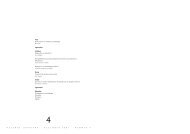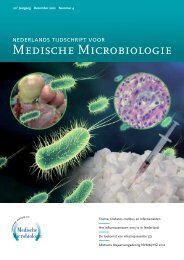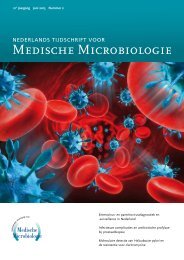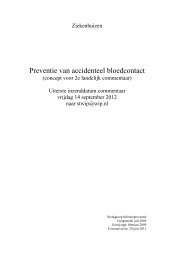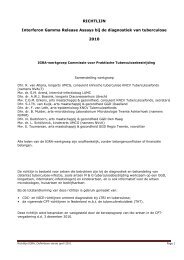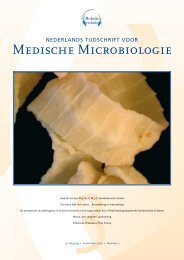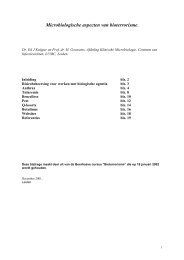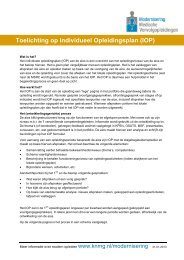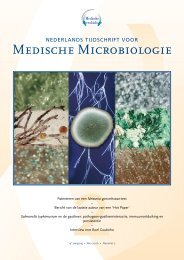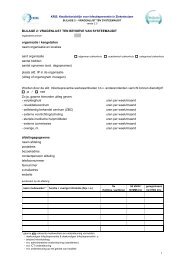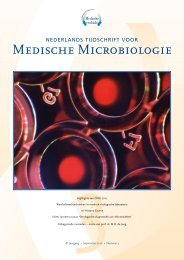S1 De voorjaarsbijeenkomst van de Nederlandse ... - NVMM
S1 De voorjaarsbijeenkomst van de Nederlandse ... - NVMM
S1 De voorjaarsbijeenkomst van de Nederlandse ... - NVMM
You also want an ePaper? Increase the reach of your titles
YUMPU automatically turns print PDFs into web optimized ePapers that Google loves.
of A. fumigatus spores in the air inhaled by these patients<br />
is crucial for infection control. In the present study,<br />
a new and rapid technique for the quantificatin of A.<br />
fumigatus, based on solid phase cytometry and immunofluoresent<br />
labelling, was <strong>de</strong>veloped. Air samples were<br />
collected by impaction on a water soluble polymer that was<br />
sub sequentely dissolved. A part of the sample was filtered<br />
and microcolonies were allowed to form on the filter for 18<br />
hours at 47°C. Subsequentely, labelling with a monoclonal<br />
anti-aspergillus antibody and tyrami<strong>de</strong> signal amplification<br />
was used to <strong>de</strong>tect the microcolonies with the aid of a solid<br />
phase cytometer (ChemScan RDI). The <strong>de</strong>tected spots<br />
were microscopically validated using an epifluorescence<br />
microscope. The specificity and sensitivity of the assay<br />
were evaluated by testing pure cultures of 40 A. fumigatus<br />
strains, 12 other Aspergillus species, 14 different Penicillium<br />
species and 14 other filamentous fungi. All A. fumigatus<br />
strains yiel<strong>de</strong>d labelled microcolonies, which confirmed<br />
the sensitivity of the assay. Only Rhizopus stolonifer and<br />
Paecilomyces varotii were labelled with the antibody and<br />
were able to form microcolonies at 47°C. These fungi,<br />
however, could be discriminated from A. fumigatus based<br />
on morphology. Comparison with traditional culture-based<br />
methods indicated that our novel approach is a rapid and<br />
reliable alternative with a high dynamic range.<br />
O043<br />
Comparison of PCR-reverse line blot and real-time PCR for<br />
the <strong>de</strong>tection of <strong>de</strong>rmatophytes in clinical samples<br />
G.J. Wisselink, E. <strong>van</strong> Zanten, S. Coops,<br />
A.M.D. Kooistra-Smid<br />
<strong>De</strong>pt. of Research and <strong>De</strong>velopment, Laboratory for Infectious<br />
Diseases, Groningen<br />
Objectives: In a previous study PCR-Reverse Line Blot<br />
(PCR-RLB) was compared with culture and the potassium<br />
hydroxi<strong>de</strong> test (KOH) for the <strong>de</strong>tection of <strong>de</strong>rmatophytes.<br />
PCR-RLB showed to be more sensitive than culture and<br />
KOH. Drawbacks of the PCR-RLB are the laborious nature<br />
of the test, the difficult standardisation and the interpretation<br />
of weak results. Therefore a multiplex real-time<br />
PCR was <strong>de</strong>veloped. The aim of this study was to compare<br />
PCR-RLB analysis with multiplex real-time PCR for the<br />
<strong>de</strong>tection of <strong>de</strong>rmatophytes.<br />
Methods: Both PCR-RLB and real-time PCR targeted the<br />
IT<strong>S1</strong> region located between the genes coding for 18S and<br />
5.8S rRNA. The RLB membrane harboured 13 different<br />
probes to i<strong>de</strong>ntify and discriminate between 9 different<br />
<strong>de</strong>rmatophyte species. Real-time PCR consisted of two<br />
multiplex assays. One assay targeted Trychopython rubrum,<br />
Trychopython violaceum and Trychopython tonsurans. The<br />
second targeted Microsporum spp., Trychopython interdigitale<br />
group and the whole group of <strong>de</strong>rmatophytes.<br />
Ned Tijdschr Med Microbiol 2008;16:Supplement<br />
S20<br />
Phocine herpes virus-1 was used as internal control for the<br />
real-time assays. Samples were processed using QIAamp ®<br />
DNA mini kit (Qiagen, Germany) with a separate pre-lysis<br />
step.<br />
In total 100 clinical samples (52, 38, 10 respectively nail-,<br />
skin- and hair samples) were analysed retrospectively by<br />
real-time PCR and compared with PCR-RLB.<br />
Results: Of the 100 samples, 60 were positive with the<br />
PCR-RLB (27 T. rubrum, 14 T. interdigitale, 6 T. tonsurans, 3<br />
T. violaceum, 1 Moraxella canis and 9 Trichophyton spp.). All<br />
samples i<strong>de</strong>ntified as T. rubrum, T. interdigitale, T. tonsurans<br />
and T. violaceum by the PCR-RLB were confirmed by the<br />
real-time PCR. The sample which tested positive for M.<br />
canis by PCR-RLB was i<strong>de</strong>ntified as Microsporum spp. by<br />
real-time PCR.<br />
The 9 samples which scored positive for Trichophyton spp.<br />
in the PCR-RLB yiel<strong>de</strong>d weak results. Of these 9 samples,<br />
real-time PCR i<strong>de</strong>ntified 3 samples as T. interdigitale, 1 as<br />
T. rubrum, 1 as T. tonsurans, 1 as <strong>de</strong>rmatophyte positive and<br />
3 samples remained negative.<br />
The real-time PCR <strong>de</strong>tected 8 additional samples which<br />
scored negative with the PCR-RLB. Of these 8 samples<br />
real-time PCR i<strong>de</strong>ntified 4 samples as T. rubrum, 3 as T.<br />
interdigitale and 1 as <strong>de</strong>rmatophyte positive.<br />
Conclusion: These data show that real-time PCR is a<br />
sensitive method for <strong>de</strong>tection of the most prevalent <strong>de</strong>rmatophytes<br />
in nail-, skin- and hair samples. Furthermore,<br />
real-time PCR is more standardised and less laborious than<br />
PCR-RLB, making it a useful tool in routine diagnostics.<br />
O051<br />
Cross-bor<strong>de</strong>r dissemination of MRSA in the euregion<br />
Meuse-Rhine<br />
R.H. <strong>De</strong>urenberg<br />
<strong>De</strong>pt. of Medical Microbiology, Aca<strong>de</strong>mic Hospital Maastricht<br />
(azM), Maastricht<br />
Introduction: The Euregion Meuse-Rhine (EMR) consists<br />
of the bor<strong>de</strong>r regions of Belgium, Germany and the<br />
Netherlands. Cross-bor<strong>de</strong>r patient mobility and free access<br />
to healthcare facilities are important issues in the EMR,<br />
but concern is rising about the possible dissemination<br />
of methicillin-resistant Staphylococcus aureus (MRSA),<br />
since the prevalence of MRSA is different in the three<br />
countries (24%, 14%, and 2% in Belgium, Germany, and<br />
the Netherlands, respectively). The aim of the study was to<br />
investigate the dissemination of MRSA in the EMR and the<br />
emergence and possible spread of community-associated<br />
(CA) MRSA strains in hospitals in the EMR.<br />
Methods: MRSA isolates (n=152; 63 from Dutch, 40 from<br />
Belgian and 49 from German hospitals), isolated between<br />
1999 and 2004, were characterised using pulsed-field gel<br />
electrophoresis (PFGE), SCCmec typing and multilocus



